Ash Meadows National Wildlife Refuge
September – October 2019
Unique landscape is getting a new lease on its old life.
BY PETER PEARSALL
In a remote corner of southern Nevada, groves of ash and mesquite trees shelter spring-fed pools of warm, crystal-clear water that are a boon for native wildlife, some of which are rare and found nowhere else on Earth. This unexpected fertile patch—Ash Meadows National Wildlife Refuge—is where the desert springs to life.
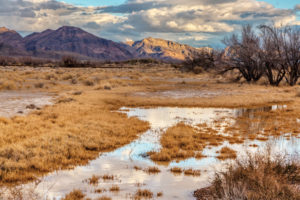
Located in one of the hottest and driest regions of North America, the 50-odd springs and seeps at Ash Meadows together discharge almost 11,000 gallons of water per minute, making it the largest remaining oasis in the Mojave Desert.
DEEP WATERS
The waters springing forth at Ash Meadows come from an ancient aquifer far below the Earth’s surface. Thick layers of porous limestone act as an enormous sponge, storing precipitation that may have fallen many thousands of years ago, when southern Nevada was a vastly different place. More than 3 million years ago, a cooler, wetter climate prevailed across the Great Basin until the late Pleistocene (around 12,000 years ago), creating vast lakes and marshes that covered the valley floors. Mammoths, giant sloths, and saber-toothed cats roamed those verdant expanses; pinyon and juniper forests carpeted the surrounding mountains.
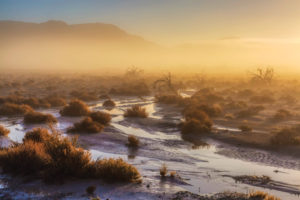
As the climate warmed, the wetlands dried up and most of those Pleistocene species disappeared. The remaining water, locked in limestone thousands of feet below ground, persisted through the eons. Forced upward by pressure, heat, and impermeable layers of rock, the water slowly percolates to the surface along faults to emerge at springs. Ash Meadows is a major discharge point for a more than 600-square-mile regional aquifer underlying southwestern Nevada.
These springs have flowed continuously for thousands of years, sustaining wildlife and humans alike with year-round water. As the Pleistocene waters receded, the springs became islands of water in the desert, serving as refugia for aquatic species such as pupfish, springsnails, and naucorids (an endemic aquatic insect). Over time, each isolated population adapted to the specific conditions of their natal spring to become a unique species: Warm Springs pupfish, Crystal Spring springsnail, and Ash Meadows naucorid. To date, 26 species of plants and animals are known to occur only at Ash Meadows, a degree of endemism nearly unmatched in the Northern Hemisphere.
Ancestors of the Newe and Nuwuvi tribes (also known as the Western Shoshone and Southern Paiute, respectively) were likely the first humans to settle in this area, engaging in small-scale farming and availing themselves of the ample natural resources: resident and seasonal game; plant materials for food, medicine, and textiles; and of course the clear, often-geothermally heated water. Their descendants remain closely connected to the area and consider the springs, marshes, and uplands at Ash Meadows to be deeply sacred and significant places.
An elder from the Timbisha Shoshone Tribe spoke about the region in a study for the U.S. Fish and Wildlife Service, saying, “We didn’t travel in from other areas to be here, [at] Ash Meadows. We were placed here. This is the area we have to protect…for future generations, people of all sorts.”
The longevity of the springs and their ancient waters, mainly their persistence through thousands of years of climatic change, can give the overall impression of permanence. The truth is that these springs, and desert springs generally, are among the most fragile ecosystems of the West.
THE HUMAN PROBLEM
The first Euro-Americans arrived at the Ash Meadows area in the 1830s and their numbers increased steadily after the 1850s. Newe and Nuwuvi lived alongside these immigrants at Ash Meadows for a time, sharing resources and knowledge of the area. But the immigrant tide was unrelenting and the indigenous inhabitants, decimated by introduced diseases, were eventually displaced. Thus began a different chapter in the human history of Ash Meadows, one in which the waters were seen not as a shared resource but as property, to be developed and utilized to the fullest extent.
The 1891 Death Valley expedition, one of the earliest explorations of the area by Western scientists, traveled along the Amargosa River drainage and spent several days in the Ash Meadows area. In a journal entry dated May 30, 1891, naturalist Clinton Hart Merriam wrote of the area, “The valley takes its name Ash Meadows from the presence of a small ash tree about many of the springs…The soil is too alkaline to be of any use for farming—hence the springs go to waste.”
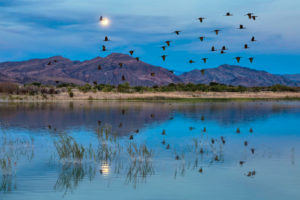
Despite the unsuitability of the soil, the water proved too irresistible for enterprising humans. Substantial human modifications to the Ash Meadows area likely began in the early 1900s and accelerated in the 1950s-1970s, as agricultural developments in the area increased demand for irrigation water. In the 1960s, the expansive marshes of Carson Slough in the northwest corner of the refuge—habitat for migratory birds and the endemic Ash Meadows montane vole—were drained and mined for peat. Riparian vegetation was cleared and alkali meadows were plowed under to make room for fields of alfalfa, cotton, and even asparagus. Spring channels were straightened, deepened, or buried in pipes to expedite delivery to crops.
Introductions of non-native species also contributed to the resource damage at Ash Meadows. By the 1950s, mosquitofish, crayfish, melania snails, bullfrogs, and sailfin mollies were established in most of the springs at Ash Meadows, and sportfish such as largemouth bass and green sunfish were introduced to the reservoirs. The endemic Ash Meadows killifish, as well as at least two endemic spring snail species, were likely driven to extinction by these introduced predators.
Don Sada, an emeritus research professor specializing in spring ecology at the Desert Research Institute in Reno, was a U.S. Fish and Wildlife Service biologist in Nevada in the 1970s. He vividly recalls the widespread degradation of habitat in the Ash Meadows area during that period.
“It was very difficult to witness,” he says. “Back in those days, I didn’t think there was any chance for native fishes and invertebrates in the springs. I reached a point where I thought I would never go back to Ash Meadows, it was that bad.”
Sada was among a core group of scientists and conservationists in the 1970s and ‘80s that was intent on protecting the unique habitats of Ash Meadows. At that point, the area had already been the stage for an intense legal battle regarding the fate of a small, unique, extremely isolated fish: the Devils Hole pupfish.
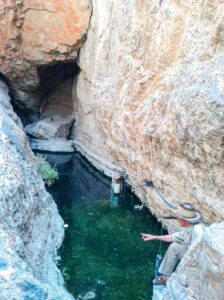
A TINY SAVIOR
When Devils Hole was added to what was then Death Valley National Monument by presidential proclamation in 1952, federal protections for wildlife did not yet exist. By the 1960s, groundwater withdrawals for irrigation in Ash Meadows and nearby Amargosa Valley were causing the water level in Devils Hole to drop, imperiling the fish’s only habitat. In 1967, as both the water level and the pupfish population continued to fall, the species was listed as federally endangered under the nascent Endangered Species Act. After a Supreme Court decision in 1976 ruled that the federal government was entitled to reserve water rights for protection of the pupfish, large-scale agricultural activities in the area were effectively halted.
But the protection of Devils Hole and its pupfish did not extend to the endemic species dwelling in and around the springs of Ash Meadows. After agricultural production waned following the 1976 Devils Hole decision, real-estate developers began taking an interest in Ash Meadows. In the late 1970s, plans were drawn up to create a 50,000-person resort community near the springs, complete with gridded streets and an artificial lake. According to studies done by the U.S. Geological Survey during this period, water use by this planned community would’ve exceeded the annual discharge rate of Ash Meadows by 370 percent.
It took the concentrated efforts of those like Don Sada and others from tribal and conservation groups to convince lawmakers and the public that Ash Meadows was unique, significant, and—like Devils Hole—equally deserving of federal protection. After a hard-fought process, Ash Meadows was eventually acquired by The Nature Conservancy in February 1984, under agreement that the land be transferred to the U.S. Fish and Wildlife Service and protected as a National Wildlife Refuge.
While finally under the auspices of the U.S. Fish and Wildlife Service, work to recover the varied species and habitats at Ash Meadows was only beginning. By the time Ash Meadows NWR was established on June 18, 1984, almost all of the area’s springs were heavily altered by human activity. The manipulation of spring flow, the removal of native vegetation, and the introduction of non-native species all served to impair the ecological processes that had previously governed life at Ash Meadows. The fine-tuned balance of adaptation and speciation, of life lived on a razor’s edge under extreme conditions, was all too easily thrown off-kilter by human intervention. Now—again at the hands of humans—those processes are being restored, year by year.
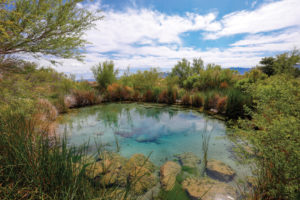
Efforts to restore natural hydrology and native vegetation communities to the springs at Ash Meadows began in the 1990s and continue today. Longstreet Spring, Crystal Spring, Kings Pool, and the Warm Springs area are among the major restoration projects undertaken in recent years. With approval and funding, other springs will eventually be restored.
Ash Meadows, a truly one-of-a-kind place, has been spared the fate of so many other treasured natural areas in the West: undervalued, overused, and eventually left to waste. The protection of Ash Meadows’ unique flora and fauna, its rich human history, and its many springs and wide-open spaces for all to enjoy is a legacy that will hopefully be passed on for generations to come.
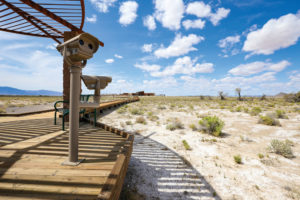
As the writer Chris Norment sums up in his book “Relicts of a Beautiful Sea,” “At Ash Meadows it is possible to understand something of isolation and evolution, islands and sanctuaries, the harmful press of exotic species, habitat destruction and restoration, the ebb and flow of Pleistocene waters, extinction and resilience, the misguided use of the desert’s water, and how a few dedicated people can put things right.”

